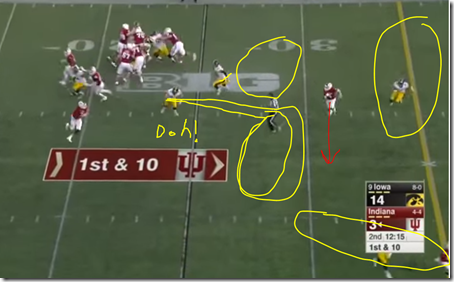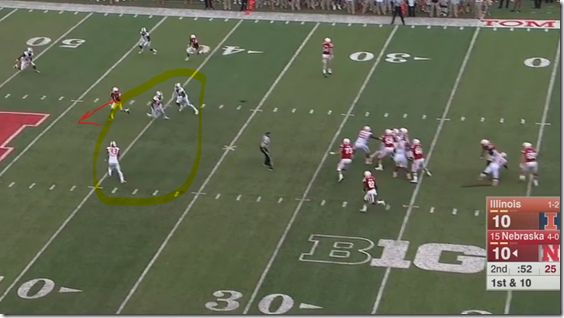A lot of top FBS coaches made it there by being experts or even the originators of a concept. Iowa didn’t invent Cover 2, but Ferentz’s teams have run it for so long that his players have instinctualized most of its nuances, and his coaches know the fastest route to teaching it. Rich Rodriguez built the zone read option into the spread ’n shred offense. He can run it against anyone because he knows a million ways to tweak it to deal with whatever defenses try to do to stop it. Same with the pattern-matching variant of cover 3 that Saban and Belichick created for the Browns. Rocky Long is going to run a 3-3-5, or run his 3-3-5 stuff out of different looks. Bud Foster is going to hit you with quarters all day. Tracy Claeys is going to play man.
Michigan’s next opponent is one of those guys. Lovie Smith built a good NFL coaching career by running the Tampa 2 defense, and Illinois is currently experiencing the growing pains of that conversion. Smith’s defensive coordinator is Hardy Nickerson Sr., who imported his eponymous son from Cal to play the crucial middle linebacker role—that is not going well. Last week against Rutgers they blew up the depth chart, sitting longtime starters at all levels for freshmen redshirted and not. When you decide what you want the rest of your life to be, you want the rest of your life to start right away, no matter how long Taylor Barton has started for you (or Brian’s Draftageddon team).
This baby version gives us football laymen an interesting opportunity to see Smith’s scheme in Rodriguez 2008 mode, when the skeleton of the thing is there and untainted by all the things its practitioners will learn to do to make it good. So once you see the concept, it should be uniquely easy this Saturday to pick it up on the field.
[Hit THE JUMP to watch it run so badly you can see exactly why it’s run]
Good ol’ Cover 2
I expect you know what Cover 2 is, since if you’re of age to be reading this site chances are most of your football-watching life came during its heyday, which arrived with the Steel Curtain and hasn’t gone away. You’re also probably used to some of its lessons, because the current and last generations of football announcers tend to think in its terms.
Cover 2 is still the safest base defense against X offense. Your corners and linebackers are all lined up across the midzone, just far enough from the line of scrimmage that they can cover everything an offense can attack before pass protection is a factor, and close enough to react to anything shallow, e.g. the running game. That leaves you two luxurious safeties to patrol over the top and keep things from getting out of hand. Its major downsides are that it takes a long time to get good at it (Cov 1 and Cov 3 are relatively easier to install), it takes a lot of speed, it’s relatively passive, and it’s so ubiquitous that every offense has long-practiced ways to attack it.
Here’s Iowa running a basic Cover 2 against a highly modern Indiana run-pass-option. I want you to find and watch the middle linebacker:
That MLB shot up into his gap when he read run blocking. Instead, Sudfeld pulled and knew right where a guy would be open:
The middle linebacker is a primary run defender, and has a short zone he should be able to defend while handling that running hole, unless he totally jumps out of it.
Cover 2 maximizes all the benefits of zone coverage: your players are all facing the play and in a position to react, creating interceptions and jarring hits. With so many guys in coverage it’s hard to find room to pass, especially if the offense isn’t running concepts specifically designed to stretch those zones.
Your cornerbacks can help in edge defense too, since they’re not just staring receivers. The holes between zones are in places that aren’t easy to attack, like on the sideline 25 yards downfield, and can be mitigated or totally erased with speed and quick reaction time. And if there’s a run, all seven box defenders are hanging out right there to attack their gaps.
The biggest downside is it puts a LOT on the safeties. They’ve got to help corners over top, and stay over vertical-releasing inside receivers, and cover post and in-routes where the receiver naturally has position. Linebackers reacting to the run leave safeties in horrible positions all the time, and the safeties themselves still have to help against the run. And one safety breakdown is for all the yards.
A Little 3 in Your 2
The Tampa 2 gives them some help from the middle linebacker, who gives up some run defense to cover that nasty hole between the safeties. At the snap, the Tampa 2 MLB will turn his hips toward the passing strength of the offense and gets depth to cover a short middle third of the field.
That frees the safeties up from their most terrifying responsibilities so they can play aggressively against the other stuff. With more safety help in the deep thirds the cornerbacks can play more aggressively underneath. And if the offense does attack the space the MLB abandoned, well, you’re right smack in the middle of the defense—somebody is going to close that down quickly.
The tradeoff is you’re still taking strength away from the middle, both in giving the OLBs/nickel more space to cover, and moving a run defender out of the box. Tampa 2 teams are nearly always running a 4-3 gap scheme up front, and commonly send their DTs hard upfield at the snap to dissuade offenses from running at that weakness.
When given a middle linebacker who can handle all of that vertical space and still come down super-fast on any attack in the middle, this defense can be devastating. Look no further than the 2006 Chicago Bears, coached by Lovie Smith, with once-in-a-generation luxury of Brian Urlacher in the middle.
That was an age when everyone in the NFL was running the West Coast Offense, which was fine-tuned to attack the space between the linebacker and safety level. Mixing that up took away a lot of those crossing routes and posts and ins that everyone was best at.
Show?
Ace clipped this to show how bad Hardy Nickerson is but it’s a good example too of Illinois running their base coverage.
The Cover 2 CBs carry their WRs deep if #2 inside targets aren’t attacking their side of the field. You can see they’re staying above those receivers, but looking in. The one on the top of this shot is watching the TE’s release—when that goes to the flat the CB signals to the nickel/SAM on the hash mark that the TE’s his.
That OLB got on top of the slot receiver’s route initially, because those quick seams are always the first concern a defense has to deal with. But now that’s dealt with, it’s time to hand the slot receiver off. The receiver goes inside, and the SAM tells his MLB, who should be right there, that the slot’s going inside.
Except the MLB isn’t in his zone.
Notice the two OLBs are about 5 yards from the line of scrimmage and just inside the hash marks. Either one of them can handle anything thrown between them, and they’re both in position to come down against anything in the box, and either tackle or chase anything in the flat to help.
There’s also an MLB between them. He is useless there. He isn’t in his Tampa 2 zone—he’s playing this like a regular old fashioned Cover 2. So when the slot receiver’s post route goes to the VERY SPOT THIS DEFENSE WAS DESIGNED TO TAKE AWAY. Armstrong sees it and doesn’t miss.
So they’re not good at it yet. Video:





